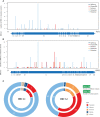Analysis of BRCA Germline Mutations in Chinese Prostate Cancer Patients
- PMID: 35251954
- PMCID: PMC8892236
- DOI: 10.3389/fonc.2022.746102
Analysis of BRCA Germline Mutations in Chinese Prostate Cancer Patients
Abstract
Recent studies have indicated that prostate cancer (PCa) with BRCA2 mutations is more aggressive. However, these reports mostly focused on Caucasus populations, and large-scale studies on BRCA mutations in Chinese PCa populations remain limited. Herein, we screened, from multiple centers in China, a total of 172 patients with PCa carrying BRCA1/2 germline mutations. The variant distribution and type, associated somatic variant, and frequency of the BRCA germline variants in these patients were analyzed retrospectively. We found that Chinese patients with PCa carrying BRCA1/2 germline mutations were diagnosed at an earlier age, i.e., 67 years (range, 34-89 years), and most had metastatic castration-resistant PCa (mCRPC) (54.65%, 94/172). The top three BRCA variants were frameshift, missense, and splicing variants. The overall pathogenic rates of the BRCA1 and BRCA2 variants were 17.46% (11/63) and 56.55% (82/145), respectively. Among the somatic mutations associated with BRCA2 germline mutations, the highest frequency was for FOXA1 (circulating tumor DNA [ctDNA] sequencing, 7.4%; tissue samples, 52%) and NCOR2 mutations (ctDNA sequencing, 7.4%; tissue samples, 24%); TP53 was the dominant somatic mutation associated with BRCA1 germline mutations (ctDNA sequencing, 25%; tissue samples, 17%). Ultimately, in Chinese patients, PCa with BRCA1/2 germline mutations tends to be more aggressive. Compared with BRCA1, BRCA2 has a higher frequency of germline pathogenic mutations. FOXA1, NCOR2, and TP53 somatic mutations associated with higher BRCA1/2 germline pathogenic mutations. Our description of BRCA germline mutations in the Chinese PCa patients provides more reference data for the precise diagnosis and treatment of Chinese PCa patients.
Keywords: BRCA variants; BRCA1 and BRCA2 germline mutations; pathogenic rate; prostate cancer in China; somatic mutation.
Copyright © 2022 Chen, Xia, Xue, Huang, Lin, Liu, Liu, Zhang, Zhang, Wang, Yang, Dong and Yu.
Conflict of interest statement
Authors TL, YZ, PZ, JW and YY were employed by company GloriousMed Clinical Laboratory Co., Ltd. The remaining authors declare that the research was conducted in the absence of any commercial or financial relationships that could be construed as a potential conflict of interest.
Figures




References
-
- Khazaei Z, Jarrahi AM, Momenabadi V, Ghor F, Goodarzi E. Global Cancer Statistics 2018: Globocan Estimates Of Incidence And Mortality Worldwide Stomach Cancers And Their Relationship With The Human Development Index (HDI). Adv Hum Biol (2019) 9(3):e1257. doi: 10.4103/2321-8568.262891 - DOI
-
- Gallagher DJ, Cronin AM, Milowsky MI, Morris MJ, Bhatia J, Scardino PT, et al. . Germline BRCA Mutation Does Not Prevent Response to Taxane-Based Therapy for the Treatment of Castration-Resistant Prostate Cancer. BJU Int (2012) 109(5):713–9. doi: 10.1111/j.1464-410X.2011.10292.x - DOI - PMC - PubMed
LinkOut - more resources
Full Text Sources
Research Materials
Miscellaneous

